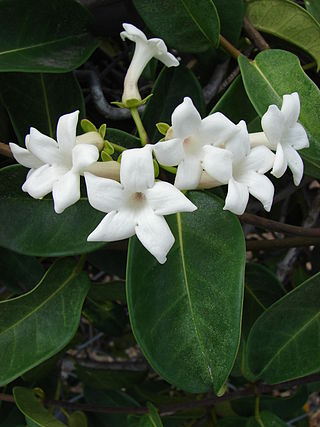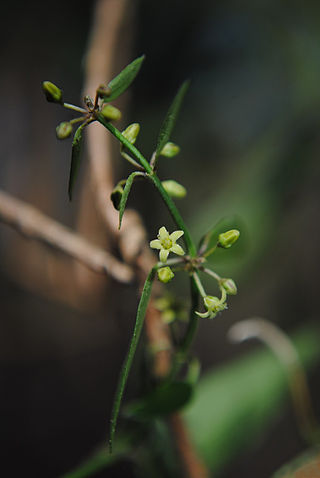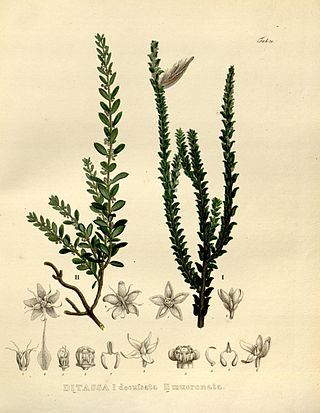
The Asclepiadoideae are a subfamily of plants in the family Apocynaceae. Formerly, they were treated as a separate family under the name Asclepiadaceae, e.g. by APG II, and known as the milkweed family.

Cnidoscolus is a plant genus of the family Euphorbiaceae first described as a genus in 1827. The group is widespread across much of North and South America, including the West Indies.

Abolboda is a genus of flowering plants, traditionally and nowadays assigned to family Xyridaceae. It is native to South America and to the island of Trinidad, generally on marshy savanna.

Dyckia is a genus of plants in the family Bromeliaceae, subfamily Pitcairnioideae.

Marsdenia is a genus of plants in the family Apocynaceae first described as a genus in 1810. It is named in honor of the plant collector and Secretary of the Admiralty, William Marsden. The plants are native to tropical regions in Asia, Africa, Australia, and the Americas.

Araujia is a small genus of perennial vines in the dogbane family first described as a genus in 1817. The group is native to South America.
- Araujia angustifolia(Hook. & Arn.) Steud. - Brazil, Paraguay, Uruguay, NE Argentina
- Araujia graveolens(Lindl.) Mast. - Brazil
- Araujia herzogii(Schltr.) Fontella & Goyder - Bolivia
- Araujia hortorumE.Fourn. - Brazil, Paraguay, Uruguay, NE Argentina
- Araujia megapotamica(Spreng.) G.Don - Brazil, Uruguay, NE Argentina
- Araujia plumosaSchltr. - Brazil, Paraguay, Bolivia, NW Argentina
- Araujia sericiferaBrot. - white bladderflower, cruel vine - Peru, Brazil; naturalized in parts of South Africa + United States
- Araujia stuckertiana(Kurtz ex Heger) Fontella & Goyder - Cordoba in Argentina
- Araujia subhastataE.Fourn. - Brazil
Calostigma is a genus of flowering plants in the family Apocynaceae, first described as a genus in 1838. The genus is native to South America.

Orthosia is a genus of plants in the family Apocynaceae, first described as a genus in 1844.
Tassadia is a genus of plants in the family Apocynaceae, first described as a genus in 1844. It is native primarily to South America, with one species extending north into Central America, S Mexico, and Trinidad.

Barjonia is a genus of flowering plants in the family Apocynaceae, first described as a genus in 1844. They are native to South America.
Minaria is a genus of flowering plants in the family Apocynaceae, first described as a genus in 2006. They are native to Brazil and Bolivia in South America.
Nephradenia is a genus of plants in the family Apocynaceae, first described as a genus in 1844. They are native to South America.

Macroditassa is a genus of plant in family Apocynaceae, first described as a genus in 1927. It is native to South America.

Ditassa is a genus of plant in the family Apocynaceae, first described as a genus in 1810. It is native to South America.
Petalostelma is a genus of flowering plants in the family Apocynaceae, first described as a genus in 1885. They are native to South America.
Melinia is a genus of plants in the family Apocynaceae, first described as a genus in 1835. It was initially given the name Brachylepis, but this turned out to be an illegitimate homonym, meaning that someone else had already used the name for a different plant. Melinia is native to South America.
- Melinia eichleri(E. Fourn.) K. Schum. - Brazil
- Melinia peruvianaSchltr. - Ayacucho in Peru
- Melinia volcanenseKrapov. & S. Cáceres - Jujuy Province in NW Argentina

Peplonia is a group of plants in the family Apocynaceae first described as a genus in 1844. The entire genus is endemic to Brazil.
- Peplonia asteria(Vell.) Fontella & E.A. Schwarz - Brazil
- Peplonia axillaris(Vell.) Fontella & Rapini - Brazil
- Peplonia bradeana(Fontella & E.A. Schwarz) Fontella & Rapini - Espírito Santo
- Peplonia hatschbachii(Fontella & de Lamare) Fontella & Rapini - Paraná
- Peplonia hilarianaE.Fourn. - Brazil
- Peplonia nitidaDecne. - Brazil
- Peplonia organensis(E.Fourn.) Fontella & Rapini - Brazil
- Peplonia riedelii(E.Fourn.) Fontella & Rapini - Rio de Janeiro
Ibatia is a genus of flowering plants belonging to the family Apocynaceae.

Ruehssia is a genus of plants in the family Apocynaceae. It is also in the Asclepiadoideae subfamily and Marsdenieae tribe.











